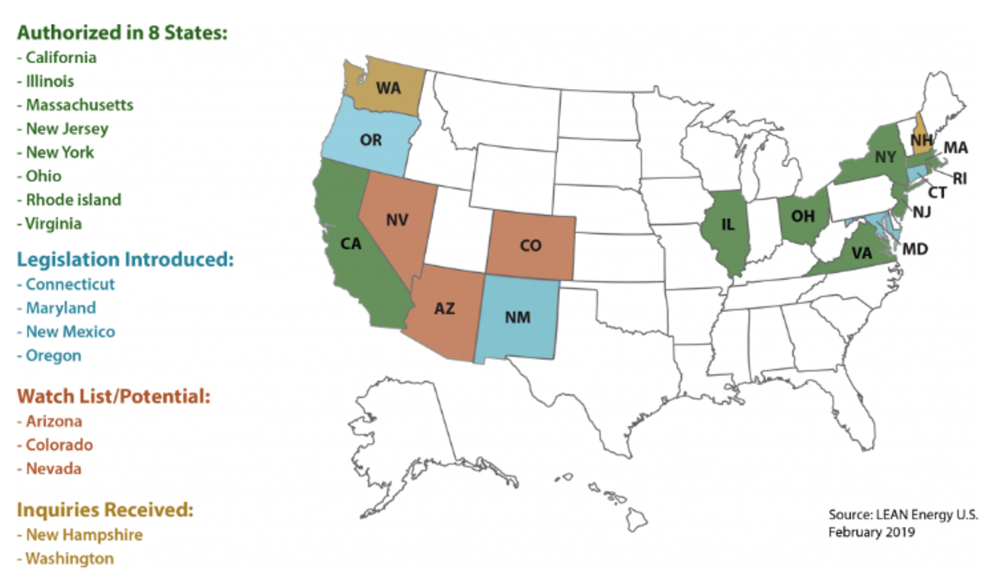If you’ve been paying attention to what’s happening in California’s solar market in the slightest bit over the past 10 years, you’re somewhat familiar with the term community choice aggregation (CCA). Since Marion County launched the first CCA program in California in 2010, the adaptation from several other counties soon followed. There are now 19 CCA programs, serving more than 10 million customers in California, while dozens of other communities are considering adopting a CCA program in the near future. California is not the only state developing community choice energy in the U.S. but is far advanced with the number of programs that have already been established.

 Click here to see an interactive map of where in California community choice is operational or being developed.
Since the CCA programs were first implemented, they have had an exponential impact on the renewable energy market. One of the biggest goals for community choice is the acceleration of the renewable market and so far, the programs have made good on the commitment to invest in new renewable energy throughout California. Results from CCAS in 2018 alone include:
Click here to see an interactive map of where in California community choice is operational or being developed.
Since the CCA programs were first implemented, they have had an exponential impact on the renewable energy market. One of the biggest goals for community choice is the acceleration of the renewable market and so far, the programs have made good on the commitment to invest in new renewable energy throughout California. Results from CCAS in 2018 alone include:
 Community choice energy is just another piece of the complex puzzle of a market that is consistently changing and evolving. At Energy Toolbase, we do our best to accommodate all these changes and provide accurate analysis for solar developers to provide to their customers. To learn more about how Energy Toolbase can accommodate CCA programs watch our latest webinar ‘Modeling solar and energy storage on CCAs’ below or visit www.energytoolbase.com to sign up for a free 14-day trial.
Community choice energy is just another piece of the complex puzzle of a market that is consistently changing and evolving. At Energy Toolbase, we do our best to accommodate all these changes and provide accurate analysis for solar developers to provide to their customers. To learn more about how Energy Toolbase can accommodate CCA programs watch our latest webinar ‘Modeling solar and energy storage on CCAs’ below or visit www.energytoolbase.com to sign up for a free 14-day trial.
What is Community Choice Energy?
So what is community choice and how does it fit into the already complex electricity puzzle? It’s a relatively recent phenomenon. Even those who have been in the industry since the first CCA program was created, still have a lack of understanding of what CCAs are and what they’re intended to do. Community choice aggregation is a local, not-for-profit program that buys and can generate electricity for residential and commercial customers. In California, it was enabled by state law in 2002 and affirmed in 2012 with the SB790 which strengthened community choice energy and established an investor-owned utility (IOU) code of conduct. Even though the initial law instructed IOU’s to fully cooperate with community choice energy, there was still a lot of obstruction, which is why the strengthened law was put into place. Community choice energy is in collaboration with the IOUs in each state where these programs are created. The three main IOU’s in California, Pacific Gas & Electric (PG&E), San Diego Gas & Electric (SDG&E) and Southern California Edison (SCE) manage the delivery of electricity, the metering and the billing while the community choice agency is solely responsible for procurement, or the generation, side of the equation. You can choose to be a bundled customer with the utility or to be a customer of the CCA. No customers are forced to be in a CCA program.
How is Community Choice Governed?
There are two main governance modes for CCAs. A program can either be a single jurisdiction, where a city or a county wants to pursue their own CCA agency and not in partnership with any other jurisdiction or a joint powers authority, where jurisdictions join together. With that, there are several requirements that must be met before a city/county can pursue their own CCA program including:- A city or county must pass an ordinance to initiate a community choice agency
- Must provide service to all customers in the city and/or county
- Must allow customers to opt-out and become bundled with the utility
- Must file an implementation plan to the public utilities commission (PUC) prior to launching service
- Exit fees: the fee that a CCA customer must pay to the utility in the particular region to offset the costs of the investments utilities have made. This is included in the customers’ monthly bill
- Must comply with the state’s mandates
Why Community Choice Energy?
Cities and counties pursue community choice for a variety of reasons but the main one being that it gives customers a choice in their energy provider other than the big investor-owned utilities. Some additional benefits include:- Local economic benefits and job opportunities
- Energy democracy
- Competitive and more stable rates
- Local control
- Greenhouse gas reductions/local air quality
- Resilience and building capacity in a community
- Serving community needs
 Click here to see an interactive map of where in California community choice is operational or being developed.
Since the CCA programs were first implemented, they have had an exponential impact on the renewable energy market. One of the biggest goals for community choice is the acceleration of the renewable market and so far, the programs have made good on the commitment to invest in new renewable energy throughout California. Results from CCAS in 2018 alone include:
Click here to see an interactive map of where in California community choice is operational or being developed.
Since the CCA programs were first implemented, they have had an exponential impact on the renewable energy market. One of the biggest goals for community choice is the acceleration of the renewable market and so far, the programs have made good on the commitment to invest in new renewable energy throughout California. Results from CCAS in 2018 alone include:
- More than 90 million dollars of estimated on-bill savings across all CCA programs
- 1,300+ megawatts of new solar PV
- 360 megawatt-hours of new energy storage
- Over 4,000 new jobs supported
- On track for 1,000 MW in 2019
Where to Next?
There are quite a few CCA programs that are in the process of emerging and expected to launch between 2020-2021. Some of those programs include:- Desert Community Energy (Coachella Valley – Center and Eastern Riverside County)
- Western Community Energy (Western Riverside County)
- Butte County Community Choice
- Hanford Community Choice (Kings County)
- San Luis Obispo and Morro Bay
- City of San Diego
- San Diego County – North Coastal Cities
- Central Coast Power (Santa Barbara County)
- City of Corona
- City of Hermosa Beach
- City of Industry
CCA’s in Energy Toolbase
CCA programs have often been a spot of confusion for solar developers when modeling projects and estimating dollar savings to present to customers. Energy Toolbase can accurately model any community choice program in the database, despite having different rate schedules than the major IOU’s. At the moment, Energy Toolbase maintains 16 out of the 19 CCA programs in California with more than 260 CCA rates in the database. Community choice aggregation rates are reviewed on a monthly basis for updates and also get updated every time their associated IOU has new effective charges. This allows our customers to have the most up to date information, saving valuable time when modeling. We say it all the time, but Energy Toolbase is a user-driven platform, meaning if you don’t see the CCA rate you’re needing, like an SDG&E CCA rate, it’s likely because it hasn’t ever been requested. To get the rate added, you will need to request it from an account manager or our utility-rates team. To see examples of how to set up a residential and commercial customer receiving supply from two CCAs in California, click here.How Community Choice Aggregation Billing Works
An advantage of dealing with a CCA is that you generally don’t have to worry about the billing details because CCA customers are billed through the main utility. The only difference is that a newly established CCA customer will see is their generation will be from the CCA and a few small additional charges from the utility will be added (exit fee, PCIA charge, etc.) Complete bills will include both distribution and generation charges. These charges can be received separately, meaning the customers’ distribution and generation come in on different billing cycles. For these customers, its important to keep in mind that bills must match corresponding data such as date range, account number meter number etc.CCA vs. Direct Access vs. Third-Party Supplier
Community choice isn’t the only other electricity program outside a utility. Developers are often dealing with direct access customers and third-party suppliers as well. One of the biggest differentiators is that generation coming from a CCA is the customer’s default supply, meaning they automatically will receive this supply and would have to opt-out before they could obtain supply from their main utility. CCA rates are also not contracted per customer, they are set rates, unlike with Direct Access and Third-party supplies whose rates vary per customer. This helps us ensure accuracy with our CCA utilizes and rates in Energy Toolbase as it allows us to add them into the database globally.Net Metering (NEM) Rules of California CCAs
Net metering rules will vary between each CCA program. Almost all of the CCAs have full retail net metering credits, even some that give you a bit extra on top of full retail: Community choice energy is just another piece of the complex puzzle of a market that is consistently changing and evolving. At Energy Toolbase, we do our best to accommodate all these changes and provide accurate analysis for solar developers to provide to their customers. To learn more about how Energy Toolbase can accommodate CCA programs watch our latest webinar ‘Modeling solar and energy storage on CCAs’ below or visit www.energytoolbase.com to sign up for a free 14-day trial.
Community choice energy is just another piece of the complex puzzle of a market that is consistently changing and evolving. At Energy Toolbase, we do our best to accommodate all these changes and provide accurate analysis for solar developers to provide to their customers. To learn more about how Energy Toolbase can accommodate CCA programs watch our latest webinar ‘Modeling solar and energy storage on CCAs’ below or visit www.energytoolbase.com to sign up for a free 14-day trial.

